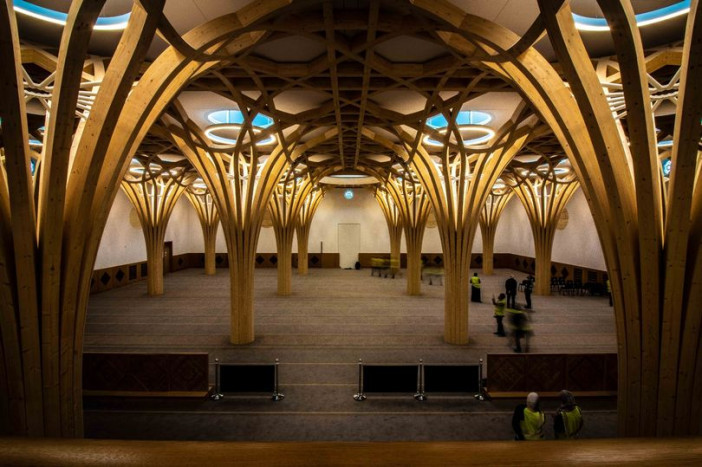
Sustainable Design
The defining feature of Cambridge Mosque is its timber structure.
The columns, or ‘trees’, reach up to support the roof in an interlaced
octagonal lattice vault structure evocative of English gothic fan vaulting,
famously used at the nearby King’s College Chapel. The timber is sustainably
sourced spruce which has been curved and laminated. Roof lights are located
above the ‘trees’, bathing the prayer hall in light. The octagonal geometry has
strong symbolism in Islamic art, suggesting the cycle of inhalation and
exhalation – the ‘Breath of the Divine’.
“The mosque is committed to
sustainability: its advanced eco-design gives it a near-zero carbon footprint,
honours natural forms with sustainable timber vaulting, and reminds the visitor
of our connection to nature.”
First Eco-Mosque
Environmental concerns have been
paramount in the design of the new Cambridge Mosque. Muslims feel a strong
imperative to protect the environment, as it is a gift from the Divine. Abdal
Hakim Murad notes that “Islamic civilization has been based on the
rejection of waste as an underestimation of God’s blessing, and so in the
construction of the new mosque here in Cambridge, we were very much at the
forefront of the local environmental movement”.
The building is naturally lit all
year round by large skylights in the roof, supplemented by low energy LED
bulbs, while photovoltaic cells on the roof help generate renewable energy from
sunlight. As well as being very well-insulated and naturally ventilated, the
mosque is heated and cooled by locally generated energy, by way of highly
efficient heat pumps in the basement that produce far more energy than they
consume. This type of heat pump extracts energy from the relatively stable
temperature of the air or ground water, heating the building as needed and
cooling it at times of high occupancy or excess heat gains.
Grey water and rainwater are
harvested to flush WCs and irrigate the grounds. The building’s carbon
footprint – which is already low – will improve over time as mains electricity
from renewable sources becomes more available. Green transport has also been
taken into consideration in the design: there is ample space for bikes and it’s
easily accessible by pedestrians, while an underground car park frees up space
on site for the mosque and gardens.
I agree to the terms outlined below:
You agree to upload and assign Mosqpedia Database the rights to use the content worldwide and in perpetuity across all current and future media platforms. Mosqpedia Database may edit, copy, adapt and translate your contribution.
The content will be distributed under the Creative Commons Attribution-Deed – Attribution-NonCommercial-NoDerivatives 4.0 International – Creative Commons
All data will be stored in line with data protection regulations.
I agree to the terms outlined below:
You agree to upload and assign Mosqpedia Database the rights to use the content worldwide and in perpetuity across all current and future media platforms. Mosqpedia Database may edit, copy, adapt and translate your contribution.
The content will be distributed under the Creative Commons Attribution-Deed – Attribution-NonCommercial-NoDerivatives 4.0 International – Creative Commons
All data will be stored in line with data protection regulations.